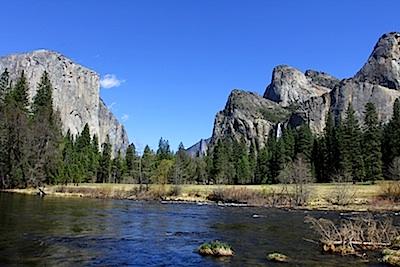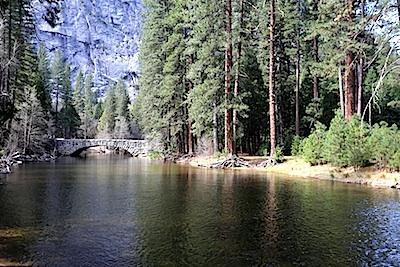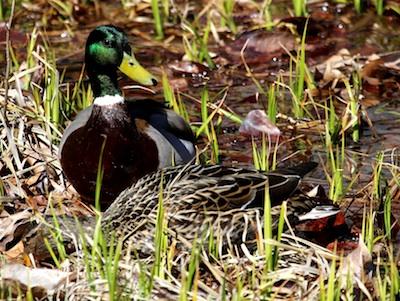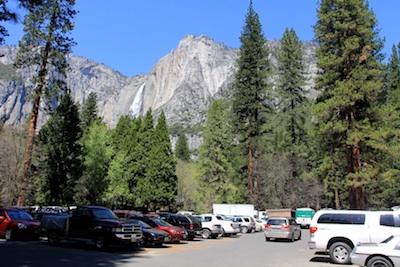
This quiet reach of Merced River will be opened up to private boating under the new river plan/Barbara Moritsch
I chose a sandy spot near a copse of willows south of the river near Sentinel Bridge. What better place to sit and ponder the recently released plan to protect the Merced as it flows through Yosemite National Park?
The river made its way down valley with a distinctive gurgle, in harmony with the clatter of small rocks tumbling downstream. The trill of a red-winged blackbird was followed by the rapid chip, chip, chip of a Steller's jay. A common flicker flew across the water just as a pair of mergansers winged their way upstream. In the still-naked branches of a black cottonwood, a kingfisher perched, motionless, ready to strike for a meal'becoming a flash of black, white, and gray when he made the dive.
As I prepared to sit, a small brown beetle with white dots splashed across its back scurried to get out of the way. It was April 10th, the turning of spring. The air temperature was close to 80 degrees and the cerulean blue sky was without a cloud. A soft breeze carried odors of resinous cottonwood buds and already drying pine needles. A smattering of concern'fire season could come early to this drought-afflicted region. Up above us all, Upper Yosemite Fall, a wide ribbon of sparkling white, made its long, rapid descent, as it has for so many cycles of so many seasons.
The Merced Wild and Scenic River Comprehensive Management Plan/EIS, released in March of this year, was a great disappointment. The plan's Executive Summary provides an overview of the selected (preferred) alternative, which became the final plan on March 31 (final, that is, unless further legal action is brought against the National Park Service). The overview's first sentence reveals how far the planning process strayed from its intended path: 'The Final Merced River Plan/EIS proposes actions that will improve the visitor experience in the park.'
That sentence has very little, if any, connection to the intent of the Wild and Scenic Rivers Act, or to the stated purpose of the plan: ''¦to preserve the Merced River in free-flowing condition and to protect the water quality and the outstandingly remarkable values (ORVs) that make the river worthy of designation.'
The claim that the plan will 'improve' the visitor experience in the park also is highly debatable. A bit of history puts the plan in context. On November 2nd, 1987, Congress designated 122 miles of the Merced as a Wild and Scenic River, from its headwaters in Yosemite National Park to Lake McClure. Yosemite contains 81 of these miles. After designation, the NPS had three years to complete a river management plan. Almost a decade later, on January 1st, 1997, the Merced River rose up in glorious flood, pulling down buildings, tearing up roads, and creating havoc in Yosemite Valley.
After the waters receded, the park started rebuilding the heavily damaged El Portal Road, a primary access route. A lawsuit was filed, questioning the adequacy of the park's assessment of the road project's environmental impacts. A U.S. District Court told the NPS to prepare the long overdue river management plan by 2000 to ensure that projects were done in a way that protected the river.
In 2000, a plan was completed. Litigation ensued. The park lost. In 2005, a new plan was completed. Litigation ensued. The park lost again.

The future of some of the valley's historic stone bridges is still in question; for the time being, they will be spared./Barbara Moritsch.
The crux of the issue was the failure of the NPS to specifically address user capacity (i.e., human carrying capacity) in the river corridor. The 2014 river plan does address user capacity, but in a frightful way. The second sentence of the overview states the plan will accommodate peak visitation levels of no more than 18,710 people at one time in Yosemite Valley. Based on models, this will result in approximately 20,100 people per day in the valley as cars and buses enter and exit the valley. This is roughly equivalent to the number of people now present on the very busiest of summer holiday weekends.
According to the Central Sierra Environmental Resource Center, a whopping 7,190 vehicles jammed into Yosemite Valley on July 2, 2011, a record for the number of vehicles in the valley in one day.
The average vehicle occupancy for day visitors is 2.9 people per car, and higher for overnight visitors. Even using the lower multiplier, this number of vehicles translates to 20,851 people in the valley in one day. This was July 4th weekend. This was a record-setting number of people. The new river plan would allow almost this many people to jam into Yosemite Valley every day of the year. And this is entirely possible, even likely, given that every year the valley's 'shoulder seasons' of spring and fall creep ever closer to winter.
This is not management that will protect the Merced River or the quality of a visit to Yosemite.
The overview says there will be marked improvements in circulation, parking availability, and traffic flow in the valley. A new and improved (i.e., larger) day-use parking lot near Yosemite Village will be fully integrated with pathways to visitor services, restrooms, and food service. This parking area is intended to give visitors a 'sense of arrival.' Silly me'I always thought the views of Bridalveil Fall, El Capitan, Yosemite Falls, Half Dome, and the river did a pretty good job of that.
Under the new plan, in Yosemite Valley, there will be 37 percent more camping (from 466 to 640 sites), 5 percent more lodging (from 1,034 to 1,082 units), and 8 percent more parking (I couldn't figure out how these numbers were derived), plus expanded picnic and day-use opportunities at Yosemite Village, Church Bowl, and Happy Isles.
Valley visitors will still get to ice skate in the winter, swim in the swimming pools, and rent bikes and rafts. This plan to 'protect' the Merced River also will allow rafting in 'new and challenging river reaches' in areas of the west valley that were previously off-limits. Say goodbye to the quiet, contemplative experiences that used to be available in the west valley.
Why did this 17-year-long, multi-million dollar planning effort result in the status quo plus more stuff in Yosemite Valley? The NPS never really proposed to do anything serious to protect the Merced, but in the draft they did call for a few minor changes to visitor use that would have improved the health of the river.
There was an immediate and strong backlash to these proposals. Politicians representing economic interests got the public up in arms, telling people the government was trying to destroy 'their Yosemite experience' and threatening to pursue a 'legislated solution' if the NPS tried to make those changes.
The hands of the NPS were tied.

The river plan does not call for adequate monitoring of the impacts of increased visitation on Yosemite Valley's wildlife or vegetation./Barbara Moritsch
The magnitude of opposition to the draft plan was way out of proportion to the proposed changes, in part because Americans for Prosperity, a Koch brothers-backed organization, was instrumental in stirring up that opposition, consistent with their ongoing efforts to cripple the federal government's ability to protect public lands in any way they can.
What if the NPS had written and aggressively supported a plan that would truly protect and benefit the river? Would a heavily-armed militia have arrived at the park gates, ready to take drastic action to protect people's 'rights' to use Yosemite Valley however they see fit?
It's possible, given people's angry reactions to the government shutdown, and the recent standoff with Cliven Bundy over grazing on public lands.
How can the NPS do its job and protect our park lands under these conditions?
Evidence of political meddling is included on page 24 of the project's Record of Decision: 'On Tuesday, July 9, 2013, a hearing by the House of Representatives Subcommittee on Public Lands and Environmental Regulation exposed for a larger national audience the conflicting public and political opinions being considered in this planning effort. Witnesses (carefully selected, I'm sure...) and committee members presented support for the following:
'¢ Continuation of Yosemite Valley recreational and commercial services.
'¢ Replacement of campsites damaged during the 1997 flood and retention of campsites within the floodplain.
'¢ Protection of Sugar Pine Bridge and other historic resources.
'¢ Consideration of the park's diverse visitors including those with physical disabilities and those of limited economic means.
'¢ Exclusion of the 81 miles of the Merced River in Yosemite National Park from Wild and Scenic River designation.
'¢ Adoption of the No Action alternative.
This was the coup-de-grace that killed the Merced River planning process, and may be the real reason the plan essentially maintains the status quo relative to activities, adds even more campgrounds, lodging units, and parking places, and allows an obscenely high user capacity in an already over-crowded, over-used Yosemite Valley.
Almost 27 years after being formally recognized for its superlative qualities as a wild and scenic river, the Merced finally has a plan for its Yosemite segments. This river deserves the very highest levels of protection as it meanders, cascades, and splashes its way through one of the world's greatest natural treasures. In fact, the ROD for the plan even states that: 'The National Park Service Organic Act...begins with the overarching mandate to preserve park resources in an unimpaired condition.'

Day use parking will increase under the new river plan/Barbara Moritsch
In this light, the Merced River plan is not even in keeping with the intent of NPS enabling legislation. The plan will only ensure that more people can do more activities in and around the river, and spend more money doing so'contributing to the further degradation of what should be clean and healthy ecosystems.
I had high hopes for the plan as a means by which we could make a firm commitment to true and lasting protection of Yosemite Valley. Maybe my hopes were too high. Maybe it wasn't the job of the river plan to be the agent of protection'but it could have been.
But the planning process was hijacked by economic/political interests, and ultimately used to increase development and use in Yosemite. How can a plan to add more campsites, lodging, parking, and people possibly be in the interest of the health and well-being of the river and its environs? It can't.
This plan represents just one more missed opportunity to do the right thing for nature in Yosemite Valley.
I watched a pair of mallards dabbling in the shallows in search of food, and I wondered: Do the animals, birds, and bugs care about this planning debacle? Do they understand this was a missed opportunity? Do they know that their care-taker, the NPS, no longer has the ability to protect them, and that it is human short-sightedness and greed that are destroying their habitat? If they do, they are far too forgiving.
Do the pines and the oaks, the grasses and the sedges care when they are cut down, scraped away, or trampled to death? Do the rocks care when they are blown up or moved? Do the soils care when they are covered by pavement?
We can't yet know the answers to these questions; therefore, it's up to us to care. It's our job to ensure all the native living and non-living entities in Yosemite Valley are protected forever from the incessant desires of ever-increasing numbers of humans. Maybe it wasn't the job of the river plan to afford this kind of protection, but it could have been. For now, we must wait and see if this 2014 plan is, in fact, the final plan.
Let's hope not.
Barbara Moritsch worked for the National Park Service as an ecologist and interpretive naturalist in five Western parks, including Yosemite. She holds Bachelor's and Master's degrees in natural resources and environmental science. She is the author of The Soul of Yosemite: Finding, Defending, and Saving the Valley's Sacred Wild Nature.



Comments
Thanks, Ron. That's basically what I've told them. Jennifer was welcomed into the world at the old hospital by Dr. Avery Sturm on January 13, 1970 and was the first baby in Mariposa County. So now she would really like to go see the place.
Between the park's website and the option of campground reservations, I hope she will be able to learn what she needs to know to enjoy it.
Lee, what a great post, Dr. Avery Sturm, he was simply an outstanding person. Both our kids were born at the old LMH as well. Your daughter is still going to love the place, all things considered, I think the NPS is doing a good job. There will be some traffic congestion on peak summer days in Yosemite Valley, but it is still worth every effort. Very best Lee, tell your daughter she is going to have a great time. My own daughter camps quite a bit both in the Valley and at Tuolumne Meadows. she still does some rock climbing.
Hi, Lee. I agree with Ron about less crowded times and camping, although I have found September to be pretty busy these days as well. October/November Sunday through Thursday seem like the best options if she would like to try for a valley campsite.
Calling McClintock corrupt simply because one does not like his ideas reflects poorly on the accuser. AFAIK, he wants to defend the locals right to make a living, and for better and for worse, Yosemite is the economic engine of the region. That certainly does not make him corrupt, unless of course, you have proof.
As for the conspiracy theory of large corporations hiding in the background somewhere to make billions off of Yosemite... What a joke! While I'm pretty sure that all concessions within the park, who probably pay big bucks to the NPS to have the right to operate there, have a vested interest in seeing more people come in, I highly doubt that they are the evil monster corporations dreamed up in this thread.
As for the overcrowding of Yosemite, it could easily be regulated by time of use pricing. Jack up the entrance price during high season until the number of visitors fall to the right number. Maybe the price should be $100, not $25 during the summer. Seems to me that the biggest to Yosemite is the number of visitors, not the ice rink.
Zebulon, I agree, calling Mr. McClintok corrupt is wrong unless specific allegations can be posted. I do not agree with Congressman McClintok's positions on most issues, but I have not seen any evidence to date that he is on the take. On the issue of just raising the fee, you are right, it has been suggested on many occasions, 100 dollars seems to be the most common starting point. I disagree with this approach, primarily because it discriminates against persons in the lower income levels. It is already expensive to travel to Yosemite for many citizens, transportation, lodging, food, etc. I have always felt that, unless you have a reservation, there maybe some days you just might have wait, one car in, one car out. This is an equitable approach that works in some other areas. I do see the private sector issue here, the super bowl being one, the stadium can hold so many people, demand drives the price. But this is a public park, not primarily a profit center. Shuttles would help also, and the day will come when we probably see that.
I agree, rmackie. Ideally, all of our national parks would be free.
Ideally, everything would be free. But we live in reality not some imaginary world.